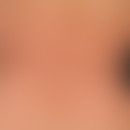Synonym(s)
DefinitionThis section has been translated automatically.
Clinically descriptive reaction pattern of the skin (response pattern) that occurs in classic and characteristic symptoms in hereditary periodic fever syndromes. The symptoms must be distinguished from spontaneous urticaria or urticarial vasculitis. The clinical combination of febrile disorder of the AZ, urticarial maculo-papular or plaque-like exanthema on the trunk and extremities, acute polyarthritis, neutrophilic leukocytosis and a marked increase in acute phase proteins is typical.
Neutrophilic urticarial dermatosis is the dermatological counterpart of Schnitzler's syndrome.
LocalizationThis section has been translated automatically.
Symmetrical exanthema with center of gravity distribution to the extremities and trunk.
ClinicThis section has been translated automatically.
Clinically an exanthema is found with 2.0 cm large or larger, less itchy (rather burning) pale red spots, flat papules or plaques that persist for about 24 hours. Quite typical is a perilesional halo formation (which can also be observed in urticaria). Occasionally oedematous facial swellings are also described. The skin changes are always accompanied by disturbance of the AZ, fever, joint complaints, neutrophilic leukocytosis and increase of the acute phase proteins (see below the respective clinical pictures). They heal with a slight hyperpigmentation.
LiteratureThis section has been translated automatically.
- Ehrchen J (2016) Neutrophil urticarial dermatosis(s). Dermatologist 67: 403-411
Incoming links (1)
Schnitzler syndrome;Outgoing links (3)
Fever syndromes, hereditary, periodic (overview); Schnitzler syndrome; Urticaria vasculitis;Disclaimer
Please ask your physician for a reliable diagnosis. This website is only meant as a reference.



